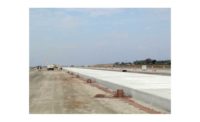The saga of 41 construction workers trapped for 17 days in a collapsed tunnel in northern India came to a close on Nov. 28, with all safely rescued through a 3-ft-dia. pipe—following the struggle to dig out a route to safety.
After an auger used to drill a rescue tunnel failed only meters from the trapped workers, the remaining debris was cleared by other workers using hand drills in an effort that took over 24 hours.
 Trapped worker exits through the rescue tunnel.
Trapped worker exits through the rescue tunnel. Photo Courtesy OpticVyu Construction Camera
But as jubilation starts to wane following the workers' rescue from the 4.5-km (2.8-mile) long Uttarakhand tunnel, government officials and tunneling experts are said to be taking a fresh look at safety guidelines, including the need to better assess the geology of the Indian Himalayas.
Minister for Road Transport and Highways Nitin Gadkari said there was a lot to be learned from the collapse and rescue. “We are going to conduct a safety audit of the tunnel, and study how we could use better technology," he said. "Himalayan strata is very fragile and it is very tough to work there, but we will have to find solution[s].”
in an interview with ENR, Manoj Verman, a tunneling and rock engineering expert and president of the International Safety Management Ratings Commission on Hard Rock Excavation said, “This tragic event has brought into sharp focus the critical role of innovative technologies in ensuring structural safety.”
Verman represents German-based Fibristerre for its patented Distributed Fiber-Optic Sensing technology in India and in several other countries. DFOS has not yet been used in India, but he says companies have shown immense interest in it. Its continuous data identifies, monitors, locates and measures strain and temperature events on long, large, and complex structures.
Poor design, selection of the lowest bidder and allowing the main contractor to subcontract to inexperienced companies without awareness of local geology are also cited by experts as possible causes of the collapse.
Once investigations are complete, there is much work still to do at the project site since the tunnel is not yet safe for construction to continue, says Abhijit Das, tunnel general manager for Ace Pipeline Contracts. “A new ‘real’ feasibility and soil analysis on the geology and soil should be carried out to see whether they can withstand the load," he says. "We should not go for shotcrete but segmental lining" similar to what is used in subways, recommends Das.
"Himalayan rocks are consolidated sediment where tunneling is treacherous," said Jagdish Telangrao Sahu, a member of a government committee responsible for framing rules for tunnel design, construction and maintenance, in a broadcast interview. He focused on the need for safety provisions, such as escape tunnels at all stages of such infrastructure, for both workers and eventual end-users.
Das agrees. “In the drill-and-blast tunneling methodology, it is crucial to establish alternative rescue plans, he says. One such method is to have a smaller-diameter pipeline laid alongside the tunnel to facilitate rescue operations.
Tunneling in India is a developing field, expedited in the past two decades without enough focus on the challenges posed by the country's geology.
“Seismic activity in certain regions necessitates stringent safety measures and innovative engineering solutions. Tunneling projects must adapt to the unpredictable nature of the geology, often leading to increased costs and construction complexities,” says Verman. He adds that the Himalayas are one of the most daunting tunneling terrains globally—noting ever-changing geology, numerous weak zones, intense stresses to issues of water ingress accessibility and logistics.
Verman calls for “more thorough site investigations than current practices, skilled professionals, enhanced design proficiencies aided by advanced geotechnical software and adoption of contemporary and innovative construction methodologies.”
He is hopeful that new guidelines will be adopted. “As India continues to increase its portfolio of tunnel ventures, the repercussions of such oversight become increasingly apparent,” he says.





Post a comment to this article
Report Abusive Comment